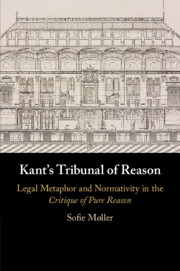
-
Select format
-
- Publisher:
- Cambridge University Press
- Publication date:
- February 2020
- March 2020
- ISBN:
- 9781108682480
- 9781108498494
- 9781108724050
- Dimensions:
- (228 x 152 mm)
- Weight & Pages:
- 0.41kg, 208 Pages
- Dimensions:
- (229 x 152 mm)
- Weight & Pages:
- 0.32kg, 212 Pages
- Subjects:
- Eighteenth-Century Philosophy, Philosophy
You may already have access via personal or institutional login- Subjects:
- Eighteenth-Century Philosophy, Philosophy
Book description
Kant's Critique of Pure Reason, his main work of theoretical philosophy, frequently uses metaphors from law. In this first book-length study in English of Kant's legal metaphors and their role in the first Critique, Sofie Møller shows that they are central to Kant's account of reason. Through an analysis of the legal metaphors in their entirety, she demonstrates that Kant conceives of reason as having a structure mirroring that of a legal system in a natural right framework. Her study shows that Kant's aim is to make cognisers become similar to authorized judges within such a system, by proving the legitimacy of the laws and the conditions under which valid judgments can be pronounced. These elements consolidate her conclusion that reason's systematicity is legal systematicity.
Reviews
‘The simplest objection to Kant's Critical project – the claim that reason cannot critique itself – is one that Kant himself not only anticipated but largely answered. Moller shows how Kant's extensive legal metaphors throughout the Critique of Pure Reason form a coherent whole intended to explain the basis of reason's self-critique. She provides the best explanation yet of how Kant defended his critical project, one that also reveals Kant's deep understanding of natural law theory.'
Frederick Rauscher - Michigan State University
‘… offers the reader a detailed and historically rich account of the legal terminology that Kant adopts or references. Møller’s book is a wonderful antidote to the sense one sometimes has, even when one reads Kant in the original, that one is still reading a slightly different and distant language.’
Source: Kantian Review
‘Møller’s book delivers on many of its central claims and should have considerable influence on those interested in Kant’s legal metaphors.’
Jessica Tizzard Source: Journal of the History of Philosophy
Contents
Metrics
Altmetric attention score
Full text views
Full text views help Loading metrics...
Loading metrics...
* Views captured on Cambridge Core between #date#. This data will be updated every 24 hours.
Usage data cannot currently be displayed.
Accessibility standard: Unknown
Why this information is here
This section outlines the accessibility features of this content - including support for screen readers, full keyboard navigation and high-contrast display options. This may not be relevant for you.
Accessibility Information
Accessibility compliance for the PDF of this book is currently unknown and may be updated in the future.


